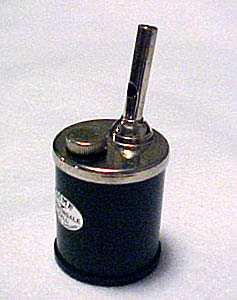- Used for special effect sounds
- Used to provide comical sounds or to stimulate a known sound
If you listen closely enough to the following song you can hear some auxiliary instruments
Examples:
This is a small version of early police and fire sirens that were mounted on vehicles and cranked by hand to rotate the blades. This is a sound effect that is normally used for humorous effects in music and to add extra comic effect for sight gags on stage and in cartoons.
Bird Whistles
 The bird whistle is a hand-held mouth-blown instrument that can be made out of metal, wood, or plastic. They are created like a simple closed flue pipe with a tube leading through the instrument that splits the air stream to create the whistle sound. The tube then leads to a chamber with water. The air is forced to agitate the water and produce a high-pitched gurgling sound that combines with the whistle to imitate the chirping of a bird. A screw on the top of the chamber can be used to adjust the degree of water agitation and change the quality of the sound to have more or less chirping quality.
The bird whistle is a hand-held mouth-blown instrument that can be made out of metal, wood, or plastic. They are created like a simple closed flue pipe with a tube leading through the instrument that splits the air stream to create the whistle sound. The tube then leads to a chamber with water. The air is forced to agitate the water and produce a high-pitched gurgling sound that combines with the whistle to imitate the chirping of a bird. A screw on the top of the chamber can be used to adjust the degree of water agitation and change the quality of the sound to have more or less chirping quality.
Finger cymbals were used together with a frame drum, during religious rites and at secular dances. Forked cymbals known as crotala traveled from Egypt to Greece and Rome, and finger cymbals were introduced from the East, chiefly for dancers, a pair being attached to the thumb and middle finger of each hand.
Slap Sticks
An instrument that creates a loud clapping or slapping sound, often called a whip. This instrument has been used in the theatre for hundreds of years. Through the years, the slapstick has been used extensively to add extra comic effect for sight gags in theatre, vaudeville, and in cartoons. It is used as the sound of whips in a number of classical and more contemporary compositions.
Triangle

The exact origins of the triangle instrument are unknown, but a number of paintings from the Middle Ages depict the instrument being played by angels, which has led to the belief that it played some part in church services at that time. Other paintings show it being used in folk bands. The triangle started appearing in marching bands as early as the 1700s.
Tambourine

All of the major civilizations of the ancient world could justifiably make claim to the invention and origins of the tambourine. Seen across ancient history and texts across the settled world, from India to the Roman Empire, to the Far East, to the cradle of civilization in Mesopotamia, many of these regions likely cultivated the instrument around the same time, with or without knowledge of it from neighboring regions.
Cowbell
While the cowbell is commonly found in musical contexts, its origin can be traced to freely roaming animals. In order to help identify the herd to which these animals belonged herdsmen placed these bells around the animal's neck. As the animals moved about the bell would ring, thus making it easier to know of the animal's whereabouts. Though the bells were used on various types of animals, they are typically referred to as "cowbells" due to their extensive use with cattle.
This is a video about the cowbell. It is kind of poking fun at how one may choose to play the cowbell but it is all in good fun and it is kind of funny. The second link is the real verson of how to play a cowbell.
http://www.youtube.com/watch?v=UT4cGVNuSnA



